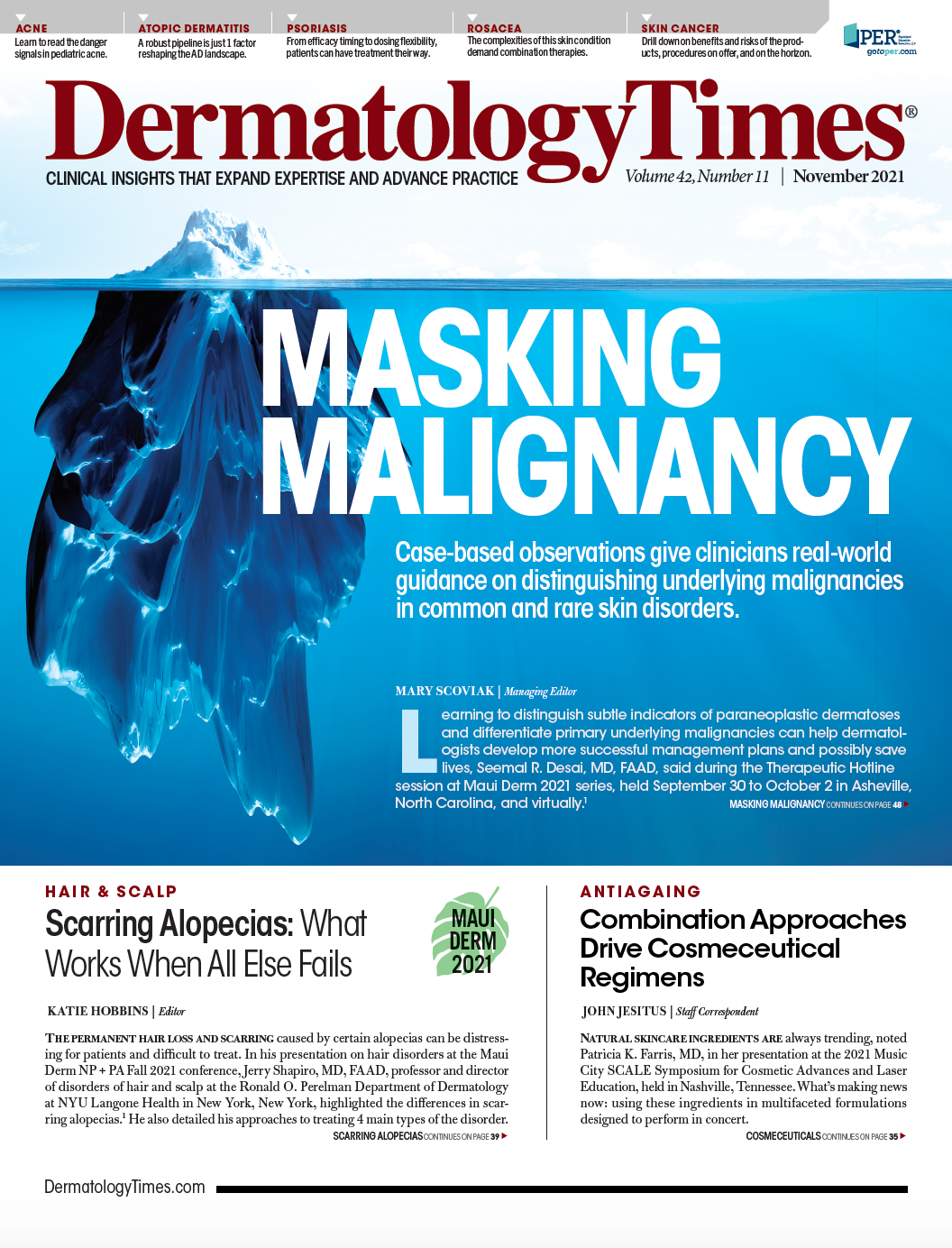- Case-Based Roundtable
- General Dermatology
- Eczema
- Chronic Hand Eczema
- Alopecia
- Aesthetics
- Vitiligo
- COVID-19
- Actinic Keratosis
- Precision Medicine and Biologics
- Rare Disease
- Wound Care
- Rosacea
- Psoriasis
- Psoriatic Arthritis
- Atopic Dermatitis
- Melasma
- NP and PA
- Skin Cancer
- Hidradenitis Suppurativa
- Drug Watch
- Pigmentary Disorders
- Acne
- Pediatric Dermatology
- Practice Management
- Prurigo Nodularis
- Buy-and-Bill
Publication
Article
Dermatology Times
New Frontiers in Laser, Light, Optical Devices
Author(s):
Innovations include underserved populations, acne, and advanced applications.
Many current laser and light-based technologies are well suited for treating patients with skin of color and pregnant patients—2 populations that typically require caution, experts in these therapies told Dermatology Times®. Future directions for light-based therapies may involve a 1726-nm laser for acne, advanced applications for photodynamic therapy (PDT), and new ways of seeing skin cells including cancers.
Lasers and Pregnancy
Patients commonly ask whether cutaneous lasers are safe to use during pregnancy, said Jill S. Waibel, MD, a Miami, Florida-based dermatologist in private practice. Babies form most vital structures during the first trimester, she said, and typically only medically necessary treatments of any modality—oral medication, surgical, intravenous, or laser—would be performed at this time. “However, after that first trimester, it could be argued that lasers would possibly be safer than an oral or topical medication that may enter bloodstream and reach the fetus,” Waibel said.
Jill S. Waibel, MD

In a review of 380 pregnant females treated with various lasers across all trimesters, the only adverse event reported was 1 case of premature rupture of membranes possibly related to laser therapy.1 Another recent review highlights the utility of nonsurgical treatments including lasers for postpartum abdominal rejuvenation.2
“Many women typically have stretch marks after pregnancy, so there’s an opportunity shortly after delivery to target the stretch marks while they’re still red with a pulsed-dye laser, followed by a nonablative fractionated laser to address the atrophic skin that we find in stretch marks,” said review coauthor Sabrina G. Fabi, MD, a San Diego, California-based dermatologist in private practice.
Sabrina G. Fabi, MD

Fabi treats such patients as early as 6 weeks postpartum. “It’s hard to juggle being able to come into my office when they’re caring for a newborn at home, but I find the earlier the better,” she said.
For postpartum skin laxity, Fabi often follows the foregoing laser treatments with microfocused ultrasound. A study by Lin et al showed that when performed 6 to 24 months postpartum, such treatments can significantly contract loose skin post pregnancy.3
Waibel added, “There are 3 different types of striae—striae rubra, striae alba, and striae distensae. The type of striae determines which laser therapy we choose.” For striae rubra, she said, pulsed-dye laser and nonablative fractional lasers work well. For striae alba, she tends to use nonablative fractional or ablative fractional laser, with laser-assisted delivery of bimatoprost. “Striae distensae are the toughest to treat. We use fractional ablative laser and laser-assisted delivery of poly-L-lactic acid,” she explained.
In 2021, dermatologists have many laser and energy devices that can treat all skin types safely and effectively. “Lasers treat many skin conditions including keloids, acne scars, hair removal, tattoos, pigmentary alterations, and photorejuvenation,” Waibel said. One of the challenges is that many patients are not aware of the advances in lasers over the past 2 decades, or they are told by their physicians that lasers are not safe for their skin type.
42-year-old Black woman with café au lait birthmark before and after 1 treatment with 1064-nm picosecond laser (Lumenis).
Courtesy of Jill S. Waibel, MD

New Acne Prospects
In April 2021, Accure Acne, Inc, Boulder, Colorado, launched a private investment offering to raise up to $20 million to support development of the Accure Laser System. It uses a 1726-nm fiber laser to destroy sebaceous glands.
In March 2020, Accure’s exclusive manufacturing partner for the product, Quanta Systems SpA, Milan, Italy, received CE Mark certification to market what, according to Accure, is the only 1726-nm laser with CE Mark clearance for acne. In the United States, preliminary results of the company’s IRB-approved FACE trial demonstrated an average lesion reduction of 80% 3 months post treatment.4
Regarding other acne-targeting technologies, R. Rox Anderson, MD, said that photodynamic therapy works well. However, he said, patients typically cannot tolerate the downtime and inflammatory reactions, and the lengthy procedure does not fit well into a busy practice.5 Anderson is Lancer Endowed Chair in dermatology and director of the Wellman Center for Photomedicine at Harvard Medical School in Boston, Massachusetts. He also serves as founder, and chief scientific and medical officer of Accure Acne.
R. Rox Anderson, MD

A system involving gold-coated microparticles to improve sebaceous-gland targeting with lasers (Sebacea Microparticles; Sebacia) has stalled. The rationale behind the microparticles, he said, is to force light-absorbing material backward into the gland, then target it with laser pulses for selective photothermolysis. The technology earned marketing clearance in Europe and the United States, Anderson said, and a European real-world trial went well; however, the US equivalent did not.6,7 “The sebaceous gland is like a lung that never inhales. It only exhales—there’s a duct, and it goes to the surface,” Anderson said.
“The gold nanoparticle concept worked very well, and if you had a hair-removal laser, wavelengths 755-nm alexandrite, 800-nm diode, or 1064-nm Nd:YAG, you only needed to purchase the nanoparticles. The treatment is easy to apply and the data are very compelling,” Waibel said.
The European postmarketing studies, in which investigators pretreated patients with a retinoid to open pores, showed after 3 in-office treatments that inflammatory acne decreased 74% at 6 months, 85% at 12 months, and 92% at 24 months.6 “Sadly,” Waibel said, “the company had a great product and great leadership, but the economics led to the close of the company during the pandemic.”
Latino patient with severe melasma before and after 1 treatment with intense pulsed light, 1927-nm laser, and tranexamic acid 650-mg half-tablet twice a day.
Courtesy of Jill S. Waibel, MD

Outside of acne, Anderson said, red-light PDT remains a mainstay treatment for actinic keratoses (AKs) and field cancerization. “There’s a fair amount of evidence that aminolevulinic acid (ALA)-PDT with red light will greatly suppress future carcinogenesis.”8,9
Therefore, PDT merits a place alongside 5-fluorouracil and other noninvasive AK treatments. “There’s strong synergy between the vitamin D analogs and both 5-fluorouracil and photodynamic therapy,” he adds.
For the future, Anderson finds nononcologic applications of PDT intriguing. Having a heavily pediatric practice, he frequently sees children with large nonresectable nevi sebaceous. Nevus sebaceous lesions are often very thick, he said. “Sebaceous glands, including the abnormal ones in nevus sebaceous, are very avid for the porphyrin pathway. So, if you get the ALA to them, they will very potently photosensitize themselves,” Anderson said.
Optical Biopsies
“Optical diagnostics is a tsunami coming our way,” Anderson said. “I don’t know when. But we will have clinical tools that are worth using. For things like Mohs surgery, it’s a game changer.”5
To optimize outcomes, Anderson explained, virtually every skin cancer and benign lesion that dermatologists now biopsy should be viewed microscopically. “I would love to be able to do the analysis at the bedside—like 1-stop shopping.”
Optical coherence tomography (OCT) involves splitting a light source and sending half of it to the skin and the other half to a reference mirror. This technology can penetrate up to 1.5 mm or sometimes 2 mm. OCT provides lower resolution than its progenitor, reflectance confocal microscopy, according to Anderson. “You don’t see the single cells that you see with confocal microscopy.” However, OCT offers the ability to perform a fast, noninvasive “optical biopsy.”
Already, OCT has transformed retinal imaging. Guillermo “Gary” Tearney, MD, PhD, of the Wellman Center for Photomedicine at Massachusetts General Hospital in Boston, is applying this technology to gastrointestinal (GI) imaging. Fruits of these efforts include a small, tethered device that patients can swallow. “It does the equivalent of an upper gastrointestinal endoscopy series,” Anderson said.
Tearney has also invented a dynamic micro-OCT tool that one day could allow cellular-level skin imaging. Although typical OCT imaging is crude at this level, Anderson said, being able to examine rates of molecular diffusion within cells can provide a functional equivalent of staining.
“I believe we’re going to make a transformation where you get cellular resolution at sufficient depth, and functional information associated with the cell metabolic rate. Things like skin cancer are going to look very different with this type of imaging,” he said. Plus, imaging several square centimeters of tissue takes only seconds.
Meanwhile, Seok-Hyun “Andy” Yun, PhD, of the Wellman Center has discovered how to turn living cells into intracellular nanolasers by programming them to genetically express green fluorescent protein.10 The process involves hundreds of half- micrometer silicon disks. These intracellular laser particles (LPs) emit tunable subnanometer spectra at hundreds of wavelengths. “It allows you to tag individual cells with a laser that goes along with that cell,” Anderson said.
Every time the cell divides, he explained, its LPs divide into the cytoplasm of its daughter cells. “And because you can make these lasers at so many different frequencies, you can track thousands of cells simultaneously.”11 In the future, Anderson said he will attempt to use intracellular nanolasers to develop tattoos that can be turned on and off.
References:
1. Wilkerson EC, Van Acker MM, Bloom BS, Goldberg DJ. Utilization of laser therapy during pregnancy: a systematic review of the maternal and fetal effects reported from 1960 to 2017. Dermatol Surg. 2019;45(6):818-828. doi:10.1097/DSS.0000000000001912
2. Kream E, Boen M, Fabi SG, Goldman MP. Nonsurgical postpartum abdominal rejuvenation: a review and our experience. Dermatol Surg. 2021;47(6):768-774. doi:10.1097/DSS.0000000000003003
3. Lin FG. Nonsurgical treatment of postpartum lower abdominal skin and soft-tissue laxity using microfocused ultrasound with visualization. Dermatol Surg. 2020;46(12):1683-1690. doi:10.1097/DSS.0000000000002576
4. Tanghetti EA, Geronemus R, Bloom B, et al. Safety and efficacy data in a pilot study of the treatment of acne with a 1726 nm fiber laser. Presented at: American Society for Laser Medicine and Surgery 40th Annual Conference; May 1, 2020.
5. Anderson RR. What next? Stories from the Wellman Center. Presented at: Maui Derm; January 27, 2021; Maui, Hawaii.
6. Waibel JS. Gold microparticles and laser for the treatment of inflammatory acne vulgaris: European real-world outcomes. Presented at: American Society for Dermatologic Surgery Annual Meeting; October 24, 2019; Chicago, IL.
7. Bhatia AC. Acne vulgaris treatment with gold microparticles and laser pulses to achieve photothermolysis of sebaceous follicles in patients using topical retinoids. Presented at: American Society for Dermatologic Surgery Annual Meeting; October 24, 2019; Chicago, IL.
8. Morton CA, Szeimies RM, Basset-Seguin N, et al. European Dermatology Forum guidelines on topical photodynamic therapy 2019 part 1: treatment delivery and established indications - actinic keratoses, Bowen’'s disease and basal cell carcinomas. J Eur Acad Dermatol Venereol. 2019;33(12):2225-2238. doi: 10.1111/jdv.16017
9. Ameluz. Prescribing information. Biofrontera Inc; 1999.
10. Gather MC, Yun SH. Single-cell biological lasers. Nat Photonics. 2011;5:406-410. doi:10.1038/nphoton.2011.99
11. Martino N, Kwok SJJ, Liapis AC, et al. Wavelength-encoded laser particles for massively multiplexed cell tagging. Nat Photonics. 2019;13(10):720-727. doi:10.1038/s41566-019-0489-0
Discosure:
Waibel is a consultant, advisory board member, and clinical trial investigator for Candela; and an advisory board member for Sciton and Sebacia. She is also a consultant for and has received equipment loans from Lumenis.
Fabi is a consultant for Merz.
Anderson is a consultant and/or adviser for Avaya, Blossom Innovations, Brixton, Cytrellis Biosystems, Follica, IPG, R2 Dermatology, and Sofregen Medical.






